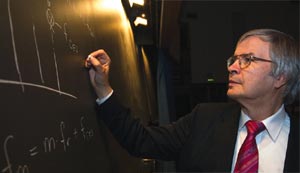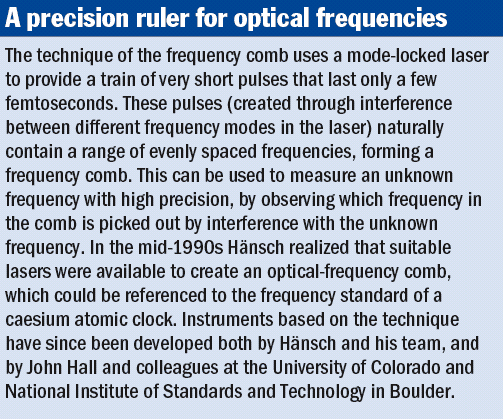Carolyn Lee talks to Theodor Hänsch, who shared the 2005 Nobel Prize in Physics for his contributions to the development of laser-based precision spectroscopy.
Theodor Wolfgang Hänsch’s interest in science began when he was six years old and living in Heidelberg, Germany. He grew up on Bunsen Strasse and one day asked his father about the name of the street and what someone had to do to have a street named after him. His father had worked in a pharmacy during the First World War and knew about Robert Wilhelm Bunsen, his burners and chemistry. So Hänsch senior brought home a Bunsen burner and would sprinkle table salt into the blue flame to reveal the yellow colour of sodium. This experience ignited the interest of the younger Hänsch and led him to study light, atoms and chemicals.

At Heidelberg he earned his doctorate from the Ruprecht Karl University in 1969. He then moved to research and teaching at Stanford University from 1975 to 1986, which was a very positive experience. “I enjoyed it right from the beginning because in Germany there were many obstacles to deal with, whereas in California administrative things seemed to be extremely easy and people were helpful,” explained Hänsch. This was the first time he had been so far away from home, experiencing different teaching styles. In the US students would see a professor after class to discuss the lecture or assignments. However, in Germany there was more of a barrier between professor and students, as there were many more students to each professor.

It was while working at Stanford that Hänsch found his mentor, Arthur Schawlow, co-inventor of the laser and Stanford University professor, who received the Nobel Prize in Physics in 1981. Although he was widely recognized, Schawlow was an easy-going person who offered a great deal of good advice for young professors.
Hänsch followed his mentor’s interest in lasers and in 1970, at the age of 28, he invented the high-spectral resolution laser. According to Hänsch, it was a simple invention that caused a great deal of excitement. This was the first laser for which the colour – wavelength – could be changed while keeping the light extremely monochromatic. This opened the door to new types of spectroscopy and greater precision in measuring frequencies, such as the transition frequency of the red Balmer line of atomic hydrogen.
A new era in laser spectroscopy began as the high-spectral resolution laser was quickly reproduced and used in laboratories around the world. Atoms and molecules are very particular about which wavelengths will excite them to higher energies. Therefore, it is necessary to use a laser that can produce the wavelength needed to excite them and to find out what that precise wavelength is.
Hänsch returned to Germany in 1986, where he became director of the Max-Planck-Institut für Quantenoptik and professor of experimental physics and laser spectroscopy at the Ludwig-Maximilians University in Munich. It was here that the challenge of finding out the particular wavelength that excited certain atoms or molecules led to Hänsch’s second invention in the mid-1990s: the optical-frequency comb generator. This invention allowed for extraordinary precision in measuring the Lyman line of atomic hydrogen, which made it possible to look for changes in the fundamental physical aspects of the universe. It was for this invention that Hänsch received his share of the Nobel Prize in Physics in 2005, the other recipients being Roy J Glauber, for his contribution to the quantum theory of optical coherence, and John L Hall, who also worked on the optical-frequency comb technique.
When asked if he was surprised to receive the Nobel prize, Hänsch explains that his friends had thought he had a good chance: “I think the year before [2004] there had been some game on the Internet where you could place bets on possible candidates, and I had come up pretty high at that time.” So he began to believe he had a real chance, but he did not expect the prize to be given for work in optics so soon; in 1997 the Nobel Prize in Physics was awarded for laser cooling and in 2001 for the Bose-Einstein condensation in dilute gases of alkali atoms.
A little-known aspect of Hänsch is his love of toys, and his own private little laboratory at the Ludwig-Maximilians University. “My students don’t even have a key to it, so I can start an experiment, give a talk somewhere, and come back to find my experiment still there,” he says. In his private laboratory Hänsch mostly works on ideas with light and is now working on how to deal with beam that is produced in a non-linear crystal, to find out its wavefronts and to correct it so that one can do meaningful experiments with it.
So what does Hänsch say to would-be Nobel laureates? His advice to young scientists is to find something that really interests you and is fun to work on. “Of course, no one can plan to win any prizes, but if you work hard at something that interests you, then every step along the way can lead to something new. One has to be prepared to put in long hours, but it makes the little triumphs extra sweet,” he said.
Currently, Hänsch is also working with the ATRAP Collaboration at CERN, which is studying hydrogen and antihydrogen atoms. If it were possible to measure precisely up to 14 or 15 digits, then it might be possible to see whether matter and antimatter are the same or if they differ in some unexpected way. This could explain why there is more matter than antimatter in the universe. To explore these questions, researchers have to look where no-one has ever looked before, and for that reason, Hänsch has a passion for precision.





